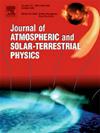Soil moisture downscaling in the state of Oklahoma: Employing advanced machine learning
IF 1.8
4区 地球科学
Q3 GEOCHEMISTRY & GEOPHYSICS
Journal of Atmospheric and Solar-Terrestrial Physics
Pub Date : 2025-01-31
DOI:10.1016/j.jastp.2025.106454
引用次数: 0
Abstract
This investigation employs a machine learning downscaling framework, explicitly utilizing the Random Forest (RF) algorithm, to enhance the spatial resolution of soil moisture data obtained from the Global Land Data Assimilation System (GLDAS) model, thereby transitioning from a resolution of 27 km–1 km, which significantly increases its utility for agricultural applications. By incorporating high-resolution predictors sourced from Moderate Resolution Imaging Spectroradiometer (MODIS) products, including Evapotranspiration (ET), Normalized Difference Vegetation Index (NDVI), Leaf Area Index (LAI), and Land Surface Temperature (LST), along with supplementary datasets such as Open Land Map Soil attributes (clay and sand fractions), NASA SRTM Digital Elevation Model (30 m), and MODIS land cover classifications (MCD12Q1), this research effectively executes the downscaling of GLDAS data. These methodological enhancements produce more precise soil moisture estimations for assessing agricultural droughts. To ensure alignment with empirical observations, this methodology incorporates Quantile Mapping (QM) bias correction, thereby enhancing the accuracy of the GLDAS data about in-situ measurements gathered over 20 years across six agricultural regions in Oklahoma. Following an evaluation of the significance of each predictor via p-value analysis, the Enhanced Vegetation Index (EVI) was omitted due to its high p-value, indicating a negligible impact on the accuracy of soil moisture estimations. The research validates the downscaled soil moisture estimations through performance metrics, including Root Mean Square Error (RMSE) Correlation Coefficients (CC), and coefficient of determination (R2), resulting in an average RMSE of 0.06 (m³/m³), which signifies concordance between the downscaled data and the observed measurements. Seasonal examination reveals that the highest correlation is observed during autumn, attributed to consistent precipitation patterns, with CC and R2 values reaching a maximum of 0.74 and 0.85 in humid regions; conversely, correlations decrease in semi-humid and arid regions, likely due to the influence of irrigation practices and diminished rainfall variability. In the final phase, the application of QM bias correction further mitigates errors, particularly improving accuracy in humid areas. These findings underscore the effectiveness of downscaled GLDAS data, augmented with various ancillary datasets, for regional drought monitoring and agricultural management. This study is a reliable resource for addressing data limitations and supporting informed decision-making of farming sectors facing resource constraints.
求助全文
约1分钟内获得全文
求助全文
来源期刊

Journal of Atmospheric and Solar-Terrestrial Physics
地学-地球化学与地球物理
CiteScore
4.10
自引率
5.30%
发文量
95
审稿时长
6 months
期刊介绍:
The Journal of Atmospheric and Solar-Terrestrial Physics (JASTP) is an international journal concerned with the inter-disciplinary science of the Earth''s atmospheric and space environment, especially the highly varied and highly variable physical phenomena that occur in this natural laboratory and the processes that couple them.
The journal covers the physical processes operating in the troposphere, stratosphere, mesosphere, thermosphere, ionosphere, magnetosphere, the Sun, interplanetary medium, and heliosphere. Phenomena occurring in other "spheres", solar influences on climate, and supporting laboratory measurements are also considered. The journal deals especially with the coupling between the different regions.
Solar flares, coronal mass ejections, and other energetic events on the Sun create interesting and important perturbations in the near-Earth space environment. The physics of such "space weather" is central to the Journal of Atmospheric and Solar-Terrestrial Physics and the journal welcomes papers that lead in the direction of a predictive understanding of the coupled system. Regarding the upper atmosphere, the subjects of aeronomy, geomagnetism and geoelectricity, auroral phenomena, radio wave propagation, and plasma instabilities, are examples within the broad field of solar-terrestrial physics which emphasise the energy exchange between the solar wind, the magnetospheric and ionospheric plasmas, and the neutral gas. In the lower atmosphere, topics covered range from mesoscale to global scale dynamics, to atmospheric electricity, lightning and its effects, and to anthropogenic changes.
 求助内容:
求助内容: 应助结果提醒方式:
应助结果提醒方式:


